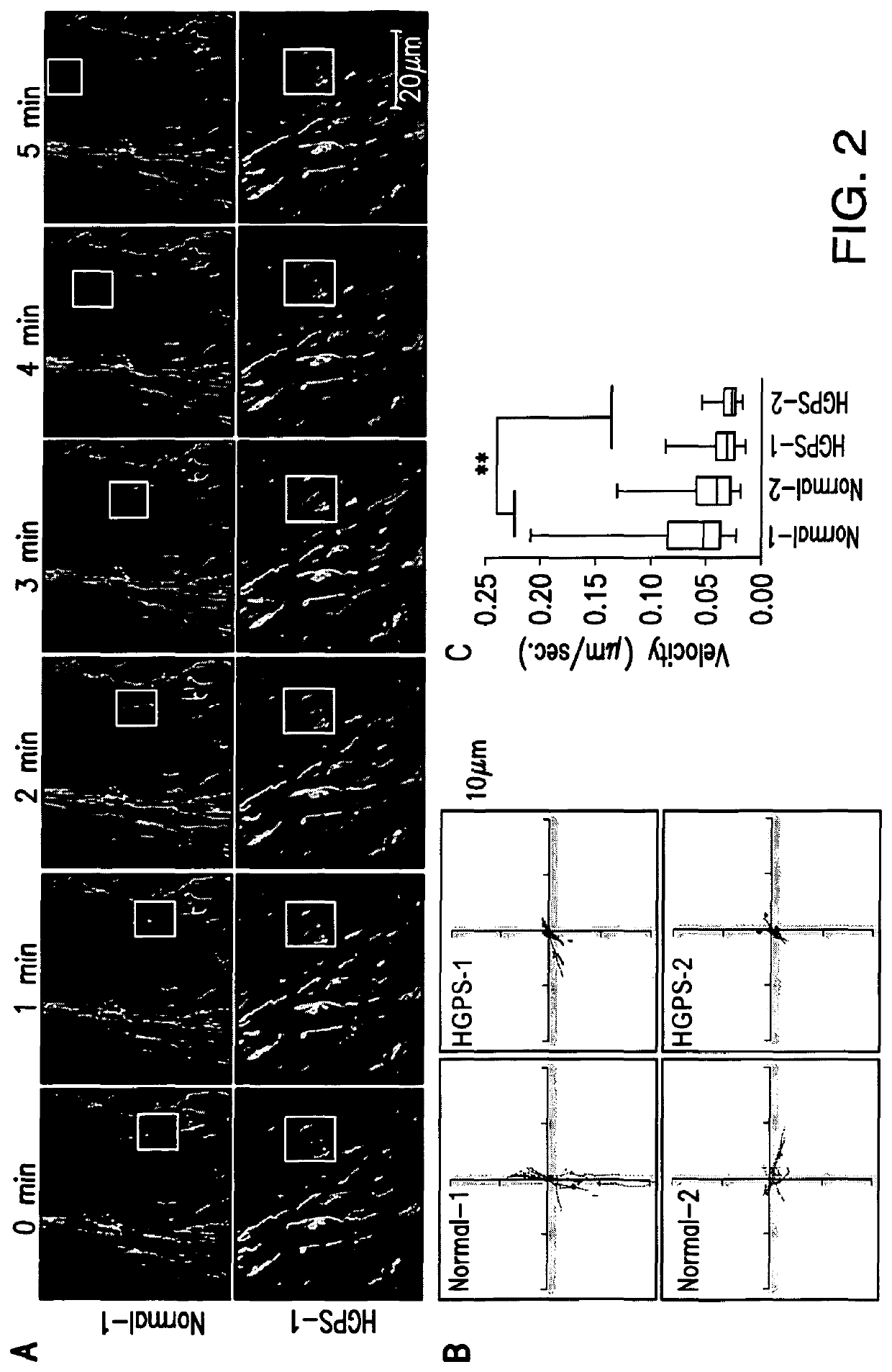Methods of treating age-related symptoms in mammals and compositions therefor
a technology of age-related symptoms and compositions, applied in the field of mammals and compositions, can solve the problems of affecting the normal functioning of the body, so as to reduce cellular stress, promote skin cell proliferation, and increase dermis thickness
- Summary
- Abstract
- Description
- Claims
- Application Information
AI Technical Summary
Benefits of technology
Problems solved by technology
Method used
Image
Examples
example 1
Progerin Expression Induces Swollen and Fragmented Mitochondria and Inhibits Mitochondrial Mobility
[0119]Mitochondria have variable morphologies classified as reticular, intermediate or fragmented according to their shape and size. This morphological diversity has linked to mitochondrial function. To visualize mitochondria in live cells, mitochondria were stained with MitoTracker and mitochondrial morphologies in two HGPS and two normal cell lines (Normal-1 and Normal-2) (details in Materials) were compared. In both normal cell lines, we observed perinuclear reticular mitochondrial network as well as a small fraction of intermediate and fragmented mitochondria (FIG. 1A). However, in both HGPS cells, a drastic increase of fragmented mitochondria were observed, with this phenotype being even more severe in one HGPS line (HGPS-2) than the other (HGPS-1) (FIG. 1A). In HGPS-2, we observed not only fragmentation but also swollen mitochondria and a complete loss of perinuclear reticular ne...
example 2
Defective Mitochondrial Behavior in HGPS Fibroblasts; Mitochondria in Progerin Expressing Cells Show Impaired Function
[0122]Mitochondrion travels long distance in the cells, along the cytoskeleton. This movement controls mitochondrial shape, intracellular distribution, biogenesis and function. To investigate mitochondrial movement in HGPS cells, we labeled mitochondria with MitoTracker Green in the two normal and two HGPS fibroblast cells and acquired live cell images at every 10 second interval for total 5 minutes, which allowed us to track intracellular migration of the individual mitochondrion (FIG. 2A). A total of 60 mitochondria from each cell line were randomly selected for moving speed and travel distance analysis. Interestingly, the mitochondria in HGPS cells showed significantly slower average speed and shorter travel distance than those in normal cells (FIGS. 2B& C). This observation was further verified in normal cells transduced by lentiviruses expressing either GFP-lami...
example 3
Progerin Suppresses PGC-1α Expression
[0126]PGC-1α serves as a master inducer of mitochondrial biogenesis through its coactivation of nuclear respiratory factors (NRFs), which control the expression of nuclear genes encoding mitochondria proteins. Using adipogenesis array, we previously reported that in HGPS adipocytes, PGC-1α was the most severely downregulated gene among the 84 genes involved in energy metabolism. To understand how progerin causes mitochondrial defects, we first examined PGC-1α in primary HGPS fibroblasts.
[0127]Quantitative RT-PCR experiments revealed that the PGC-1α mRNA level declined by eight fold in HGPS cell lines compared to normal cell lines (FIG. 3A).
[0128]Immunofluorescence staining with an anti-PGC-1α antibody revealed that while normal fibroblasts showed uniform nuclear staining of PGC-1α, HGPS cells exhibited either weakened or completely loss of nuclear staining (FIG. 3B). Quantification of PGC-1α staining fluorescence intensity in over 100 cells indic...
PUM
| Property | Measurement | Unit |
|---|---|---|
| time | aaaaa | aaaaa |
| negative membrane potential | aaaaa | aaaaa |
| body weight | aaaaa | aaaaa |
Abstract
Description
Claims
Application Information
 Login to View More
Login to View More - R&D
- Intellectual Property
- Life Sciences
- Materials
- Tech Scout
- Unparalleled Data Quality
- Higher Quality Content
- 60% Fewer Hallucinations
Browse by: Latest US Patents, China's latest patents, Technical Efficacy Thesaurus, Application Domain, Technology Topic, Popular Technical Reports.
© 2025 PatSnap. All rights reserved.Legal|Privacy policy|Modern Slavery Act Transparency Statement|Sitemap|About US| Contact US: help@patsnap.com



